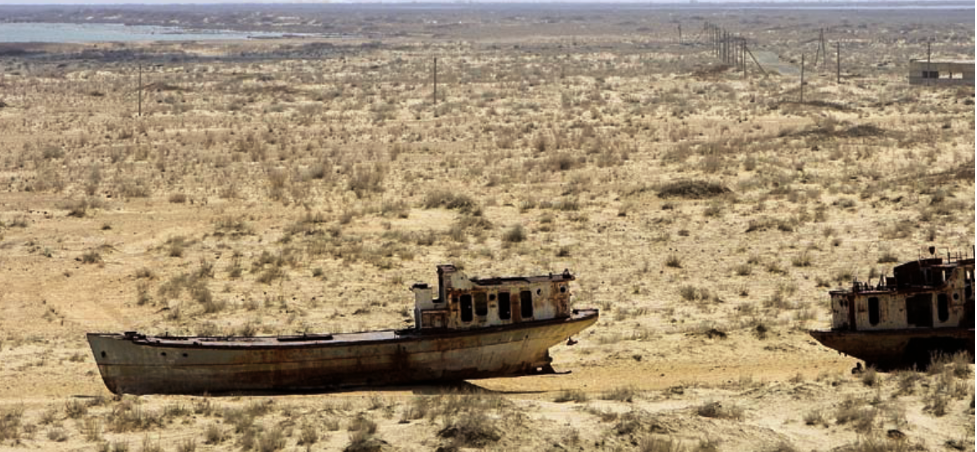The Cautionary Tale of the Aral Sea: Environmental Destruction at Economic Costs
Recent Articles
Author: Dante Schulz
12/30/2020
The loss of the Aral Sea, once spanning a large part of the Kazakhstan-Uzbekistan border, is often described as the world’s worst ecological disaster. The Aral Sea was a thriving ecologically diverse body of water until the 1960s, when the Soviet Union began diverting water from the Amu Darya and Syr Darya to bolster the region’s cotton production. Cotton production has a large water footprint and depletes surrounding water sources. As a result, cotton production and large-scale flood irrigation systems caused the Aral Sea’s water levels to drop dramatically. The once contiguous body of water has dried up into two separate entities. This in turn led to increased salinity in the sea and caused the salinization of nearby soil. The erosion of the Aral Sea is a prelude to the detrimental impacts of climate change in Central Asia, highlighting public health effects, environmental catastrophes, and agricultural concerns. Central Asian countries must coordinate their efforts to revive the Aral Sea to support its residents and revive local economies.

Satellite image of the Aral Sea in 1989 (left) and 2014 (right) | NASA
The shrinking of the Aral Sea sent economic shockwaves through local communities. About 40,000-60,000 fishermen lost their livelihoods due to the depletion of the sea. The Republic of Karakalpakstan, an autonomous region in northwestern Uzbekistan, depended on fishing and related activities to provide for approximately 50 percent of its income. Moreover, 100,000 people who depended on the fertile lands flanking the Amu Darya and Syr Darya rivers lost their jobs due to environment degradation. In addition, salinization has negatively affected soil quality in the autonomous republic, increasing the frequency of droughts that have disrupted rice and cotton production. The depletion of the Aral Sea spurred economic distress in the region, leaving many to suffer from unemployment and health effects, such as respiratory illnesses from suspended salt particles, thus prompting some to choose to migrate.
The environmental impacts of desertification in the Aral Sea Basin have been noticed throughout the entire region. Severe salt storms are more frequent, carrying salt from the dried-out Aral Sea across Central Asia. The salt not only disrupted air traffic in both Turkmenistan and Uzbekistan, but it also left a thin coat of white dust on crops, ruining farmers’ produce. Furthermore, groundwater levels have risen by 8.2 feet in some parts of Turkmenistan, which can lead to salinization of the soil. Harmful effects felt throughout the region have ignited calls for Kazakhstan and Uzbekistan to implement new protocols to revive the Aral Sea.

Abandoned ship in Kazakhstan in the former Aral Sea | Environmental Justice Atlas
Kazakhstan has instituted programs to revive the once-bustling Aral Sea fishing industry. In 2005, Kazakhstan opened the Kokaral Dam, leading to an increase of 10.8 feet in water levels after just seven months. Early reports indicate that several fishing industries in Kazakhstan are returning to the region with the preservation of the biodiversity left in the North Aral Sea. The dam was designed to prevent water from spilling over into the southern portion of the Aral Sea Basin, owned primarily by Uzbekistan. However, the South Aral Sea has almost completely dried up, offering a disparate picture in Kazakhstan’s southern neighbor.
Despite grim outlooks in the South Aral Sea, Uzbekistan has taken steps to reverse the harmful impacts of the sea’s disappearance. For example, the government inaugurated a special fund for the Aral Sea and the surrounding area under the guidance of the United Nations. The resources from the fund will be allocated towards mitigating the environmental impacts of the depletion of the Aral Sea and restoring ecological and trans-boundary waterways. Uzbekistan is also encouraging residents to plant sauxal trees, a species indigenous to Central Asia. The government hopes that this process of afforestation will prevent wind from transporting salty soil into the atmosphere. Officials hope that the new trees will replenish some of the rich biodiversity that the region lost with the sea’s disappearance.
The disappearance of the Aral Sea hints to the disastrous effects that climate change can have on the region if left unchecked. Soil salinization can yield larger sandstorms that drop toxic dust on to crops. Moreover, the depletion of the sea has raised alarm for safeguarding critical water sources to support growing populations and the region’s lucrative cotton industry. Tens of thousands of people lost their employment due to economic disarray following the depletion of the Aral Sea. Further ecological disasters could spur similar events throughout Central Asia and around the world.
The catastrophic depletion of once the world’s fourth largest lake has caused unprecedented ecological, economic, and public health disasters for local communities. The lake shrank to a tenth of its size, hampering the livelihoods of surrounding communities and causing public health issues as sandstorms and droughts to became commonplace. Kazakhstan has uncovered a solution to maintain water in the North Aral Sea but proposals to do so leave out Uzbekistan and the faltering economy in the Republic of Karakalpakstan. While these two countries are the only ones that border what remains of the Aral Sea, the body of water is a crucial resource for all of Central Asia. Central Asian countries must coordinate their efforts to mitigate the harmful effects that the depletion of the Aral Sea has brought on the region’s population and its ecosystem.